|
 Mycena podocarpi Mycena podocarpi
BiostatusPresent in region - Indigenous. Endemic
Images (click to enlarge)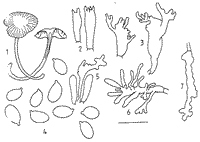
Caption: Fig. 6 M. podocarpi. 1. basidiomes. (After drawing by Mrs. G. M. Taylor) 2. basidia. 3. cheilocystidia. 4. basidiospores. 5. pleurocystidium. 6. pileipellis elements.7. terminal cell of stipe. | 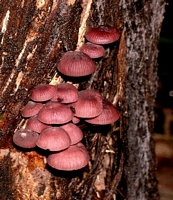
Caption: FUNNZ photo
Owner: J.A. Cooper | 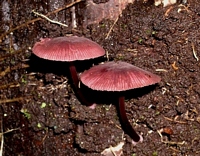
Caption: FUNNZ photo
Owner: J.A. Cooper | 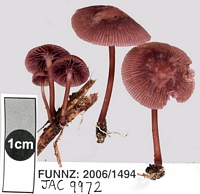
Caption: FUNNZ photo
Owner: J.A. Cooper | 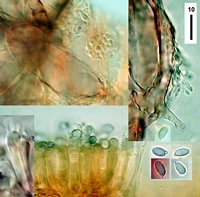
Caption: upper: cap surface. Lower basidia & spores.
Owner: J.A. Cooper | 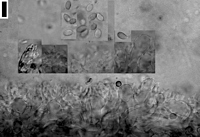
Caption: scale = 10um. Spores and diverticulate cheilocystidia.
Owner: J.A. Cooper | 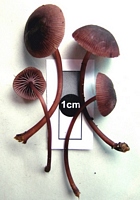
Owner: J.A. Cooper | 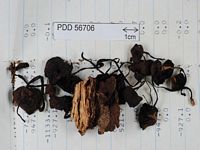
Caption: Dried type specimen
Owner: Herb PDD | |
Article: Segedin, B.P. (1991). Studies in the Agaricales of New Zealand: some Mycena species in sections Longisetae, Polyadelpha, Rubromarginatae, Galactopoda, Lactipedes, and Calodontes. New Zealand Journal of Botany 29(1): 43-62 (http://www.rsnz.org/publish/abstracts.php).
Description: Pileus 12-25 mm diam., brownish violet (11D4 K&W)
to blackish granular in the centre, hemispheric to convex, finally slightly
depressed in the middle, smooth, pellucid striate more than halfway in from
the margin. Lamellae broadly attached with a decurrent tooth, brownish purple
with a paler bloom and distinctly blackish margin, fairly distant, 3 series,
-16 reaching the stipe, relatively broad, some intervening. Stipe 40-50 X 2-3
mm, fairly even but slightly wider at the base, dark reddish purple, finely
fibrillose, hollow, insititious. Flesh pale grey-lilac. Smell and taste not
noticeable.
Spore print white.
Spores 5.5-7.5 X 3-5 (6.7 X 3.75) µm., Q = 1.78, ellipsoid-oblong, hyaline,
strongly amyloid, thin-walled, variable in size but falling into approximately
two sizes 6.1 X 3.4 µm. and 7.3 X 4.2 µm., probably depending upon being borne
on 2- or 4-spored basidia. Basidia 20-25 X 6-7 µm., 2- or 4-spored, with faint
reddish-coloured sap when fresh (brown in KOH). Cheilocystidia 20-35 X 10-15
µm., forming a broad band, extending back across the lamellar face, basically
clavate, with diverticulate, mainly apical outgrowths, which may be intricately
branched, containing reddish-brown sap, paler in the outgrowths. Pleurocystidia
fairly frequent, like the cheilocystidia with similar reddish-brown sap, only
smaller and with less complex outgrowths. Trama of more or less parallel hyphae
up lo 10 µm. diam., fairly regular, all containing red sap, very strongly vinaceous
brown in Melzer's. Subhymenium cellular. Pileipellis of repent hyphae up to
5 µm. diam. and with red sap, forming a uniform layer, with many narrow (1-3
µm.), hyaline, simple to diverticulate, relatively long, erect outgrowths. Subpellis
of globose cells (15-25 µm. diam.), with brownish-coloured sap. Context of narrow
to inflated, interwoven hyphae with reddish contents. Stipe of narrow, parallel
hyphae bearing some short, diverticulate branches with reddish-brown sap. Clamp
connections present.
Habitat: HABITAT: Caespitose on wood in mixed podocarp, Weinmannia,
Elaeocarpus forest.
Notes: ETYMOLOGY: Named after the podocarp wood on which it
was collected
The violet colour of the basidiomes and the very dark
lamellar margin, together with the reddish-coloured plasmatic pigment of most
internal tissues are very distinctive.
M. austroavenacea,
M. lividorubra, and M. podocarpi form a group of closely related,
brightly-coloured species, all with lamellar margins distinctively dark-coloured
and homogeneously sterile: cheilocystidia basically clavate, with long, often
contorted excrescences; spores small and amyloid; basidia 2-4-spored. M.
oratiensis stands a little apart in having an umbonate pileus, more strongly
decurrent lamellae; larger spores; 4-spored basidia, and nodulose pileipellis
elements. All bat M. austroavenacea grow on wood.
Microscopically
the affinities of these fungi appear to lie with the M. olivaceomarginata
(Massee apud Cooke) Massee group, which Maas Geesteranus (1986b) describes as
a very variable species, which may appear in a number of colour forms. The main
difference is the much smaller spore size of the Southern Hemisphere species
compared with the Northern ones. The original description of M. olivaceomarginata
by Massee, both in the text (Cooke 1883) and on the figure in Cooke (1881, pl.
1153 (959)), gives the spore size as "6 X 5 µm." (Close to the size
for the Southern species) and this has never been reconciled with all later
records for this species of approximately 9-13 X 5-7 µm. Recently, Singer (1989)
has described a new species of Mycena from Brazil, M. castaneomarginata
Sing., which appears , to have many of the microscopic characters of the New
Zealand species, including the small spores (6.5-7.5 X 4-4.5 µm.), but is a
much smaller fungus and lacks the bright colours. In a field identification
key to some Victorian (Australia) species of Mycena, Grgurinovic &
Holland (1982) referred to a new species, M. erythromyces nom.inal.,
which appears from the meagre morphological description to resemble M. oratiensis,
no microscopic details were supplied for comparison.
|